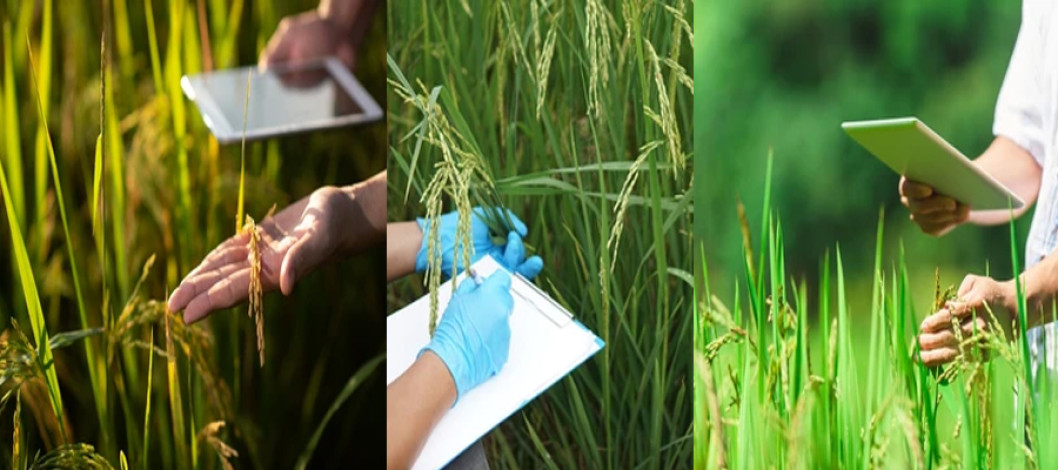
File Photo
Genetic innovations and AI-driven tech can help mitigate climate risks for rice, says the International Rice Research Institute’s incoming chief.
Yvonne Pinto, the incoming head of the International Rice Research Institute (IRRI), said innovation and eco-friendly practices in rice production must be implemented for smallholder farmers in the Global South in the face of climate threats.
With more than half of the world's population dependent on it for nearly 80 percent of their dietary needs, rice is critical to ensuring global food security, as consumption increases even as the climate crisis threatens production and the livelihoods of millions of people.
About 520.4 million metric tonnes were consumed worldwide in the 2022-23 crop year, up by almost a quarter from 437.2 million metric tonnes in the crop year 2008-2009, according to the data platform Statista. The Food and Agriculture Organization says developing countries produce and consume about 95 percent of the global rice output.
However, large rice-producing countries of Asia, such as India, Vietnam and Thailand, and regions with significant increases in rice consumption, notably in Africa, are facing increased drought risks, requiring adaptive strategies to sustain this staple crop.
“There is an imperative to replace conventional practices, such as burning straw and chemical usage in rice production, and think about agriculture as an integral part of the One Health System,” said Pinto, referring to the unified approach to optimizing the health of people, animals and the environment.
“Agriculture is about feeding the world, but it’s also about judiciously conserving our resources and ensuring that we can farm in holistic ways that are not going to destroy the planet,” she emphasized.
The alternatives to burning the straw, include harvesting it and repurposing it for animal feed or compost.
“It is vital to make these alternatives financially viable for farmers along with demonstrating their global effectiveness in reducing air pollution and associated health risks,” said Pinto, who will take over as director general of IRRI on 22 April – the first woman in the top job.
She recommended incentivizing the adoption of new technologies among farmers to bring about a change in production practices. Farmers in Vietnam and Myanmar, for example, are exploring microbial mixes for the biodegradation of rice straw.
IRRI has also developed wet and dry rice systems, direct-seeded rice (grown directly in rice fields rather than first growing seedlings in nurseries), and new varieties that reduce methane emissions from rice fields. About half the rice varieties grown in South Asia have been derived from IRRI.
Pinto, who started her career as a research scientist at IRRI in 1985, says she will lead the organization to further adopt, develop and scale climate-resilient, nutritious and productive rice varieties that enable sustainable livelihoods for farmers.
“Ensuring that farmers have access to technology, they understand its proper use and they can monitor its benefits, is essential for building resilience,” she said.
“We also need to engage with engineering faculties to explore ways to use rice stubble for biofuels, given that more than 3 billion tonnes of agricultural biomass as feedstock would be required by 2050 to ensure sustainable biofuels production.”
Pinto emphasized the need for equitable partnership collaborations with ecosystem actors including governments, the private sector, non-governmental organizations, philanthropic organizations and individual farmers.
Power of AI
She sees the potential of artificial intelligence (AI)-driven technologies and innovations in augmenting more sustainable farming solutions for rice and other crops. However, she cautions: “We need to build our confidence slowly and carefully so that we generate trust around the insights that artificial intelligence creates.”
“Agri-tech offers the opportunity to understand how we triangulate weather, rainfall, soil conditions; when and what to plant; how to monitor the performance and yield; and how and where to sell the produce,” said Pinto.
“At the other end of the technology continuum, we need to carefully understand what we have at the genetic end of the scale – the kinds of genes that are available to us, so we know how to harness them best.”
Pinto is hopeful about the role AI-driven technologies and genetic innovations can play in addressing undernourishment and malnourishment and personalizing nutrition.
She said: “There are opportunities to look at the impact of varieties, such as low glycemic index rice in the human microbiome, to understand how that enhances human health by reducing the incidence of diabetes and obesity. We can use machine learning models to understand that at a more accelerated pace than we currently do.”
United Nations chief Antonio Guterres, speaking at the UN Security Council last week (13 February), slammed the shrinking budget for climate action, warning that climate chaos and food crises are threats to global peace and security.
With funding in agricultural research becoming more challenging, CGIAR, the world’s largest publicly-funded agricultural research partnership, has challenged governments and donors to double funding to end hunger and halt climate change by 2030.
Pinto, who will also serve as the CGIAR regional director for Southeast Asia and the Pacific and country representative for The Philippines, said: “We have a tremendous opportunity for diversifying funding sources and directing the funds to where they are most needed because the need to feed the population is not going away.”
Source: Online/GFMM
Comment Now